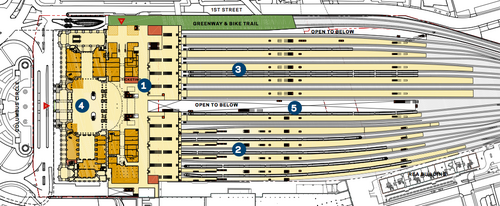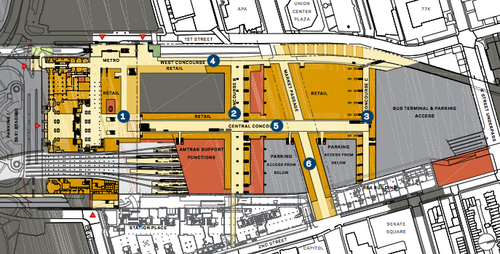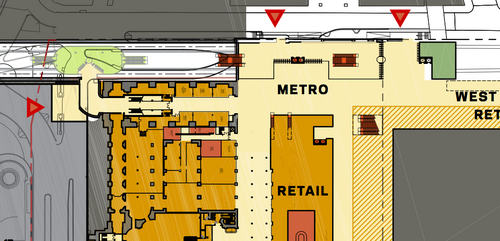Amtrak makes no little plans with Union Station vision
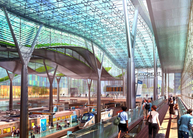
Images from Amtrak.
Yesterday, Amtrak released a master plan to guide Union Station’s growth over the next several decades. The ambitious proposal includes several key components that will make the station easier to use, increase its capacity, and ensure a strong foundation for the transportation center.
It’s somewhat fitting that this ambitious plan is attached to Union Station. The architect who designed the Beaux-Arts main station building, Daniel Burnham, is known for saying, “Make no little plans. They do not have the magic to stir men’s blood.”
This plan is a big plan. And at an estimated $7 billion, it’s an expensive plan. But it has many needed pieces. It will triple Union Station’s passenger capacity and double the number of trains.
Union Station needs to grow
According to Amtrak’s Stephen Gardner, since the station was rebuilt in 1988, the station’s annual passenger volumes have risen by more than 2 million trips. In 1988, MARC’s daily ridership was a mere 5,000. Today it’s passed beyond 33,000. The station has outgrown its capacity, and many of the stations tracks, platforms, and other facilities are old and do not meet ADA requirements.
As the plan makes clear, deferring action is not an option. Additional capacity is needed to accommodate the thousands of additional daily riders expected over the next several years.
Union Station is the second-busiest Amtrak station in the nation, falling only behind New York’s Penn Station. It handles an estimated 100,000 passenger trips each day, but the station is home to outdated infrastructure and crowded spaces.
The Union Station Master Plan sets out a framework for rebuilding and expanding the station over the next 20 years. The first 3 phases of the project are expected to cost somewhere between $6.5 and $7.5 billion, and will greatly expand capacity and usability.
Funding is not identified in the document. The region will likely need to contribute a good deal, but the station is in federal ownership and is the southern end of Amtrak’s busiest rail corridor, so some investment can be expected from outside the region.
What would a better Union Station look like?
The vision lays out a plan to improve much of the station. Here are the key elements:
Platforms and tracks are going to be redone completely. The plan is actually to reduce the number of tracks at the station, but to make use of them more efficiently. Currently, there are 20 tracks at the station. At the end of Phase 3, there will be just 18.
However, one major and early component of the project will be to lengthen and widen the platforms. Additionally, Amtrak wants to remove the parking garage above the tracks, which will let it keep the new platforms clear of obstructions like the large columns that crowd the platforms now.
While all VRE trains and the Superliner cars that Amtrak uses on its Capitol Limited can only use low-level platforms, the majority of trains operating at Union Station are designed to use high platforms. When those cars stop on a low-level platform, passengers have to navigate stairs to board and alight.
The lower level of the station currently has 6 platform tracks, all of which are low-level platforms. These tracks have access to the First Street Tunnel, which allows trains to continue south toward L’Enfant Plaza and Virginia.
Under the plan, Amtrak will add 2 new platform tracks, for a total of 8 on the lower level. 5 tracks will have high-level platforms and 3 will have low-levels.
On the upper level, the plan includes 10 high-level platforms. These are the stub-end platforms that will end directly behind the station building.
Phase 4 adds 6 (and potentially up to 9) underground tracks specifically for the NextGen Northeast High-Speed Rail. Those tracks will be built under the Upper Level platforms, and 3 will be able to extend further south under the station building to connect with the proposed Southeast High-Speed Rail to Virginia and North Carolina.
Each platform will have access at three points: at the southern and northern ends of the platforms and also in the middle.
Concourses will provide routes through the complex.
Running down the central axis of the station is a major pathway called the Central Concourse. The Central Concourse will be located one level below the tracks, starting in the area that is currently the food court.
The corridor will be 50 feet wide, and open above, with the ceiling about 100 feet up. This concourse will connect the main station building to each of the three east-west concourses that provide access to the tracks. It will also connect to the consolidated bus terminal at its northern end.
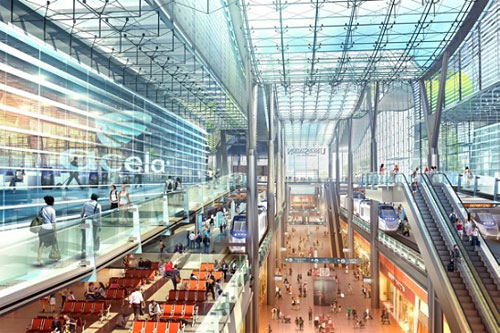
Concourse A is the current train concourse, located one level above the Central Concourse at the southern end of the platforms. It will connect the Great Hall to the train platforms, and will also include a connection to the Central Concourse.
The plan calls for most Amtrak passengers to use Concourse A to access platforms, but the platforms will be open to all passengers from any of the entrances.
Concourse B, located in the middle of the platforms, and Concourse C, located at the north end of the platforms, will primarily serve commuter rail patrons. Waiting areas for commuter trains will sit along Concourses B and C. These concourses will be on the same level as the Central Concourse, one story down from the platforms.
Additionally, a north-south connection will run along the western edge of the station, called the West Concourse. This concourse will start at the northern entrance to the Metro station and run all the way along the station to Concourse C. Along the way it will link to several new entrances along First Street NE.
One additional east-west corridor, called the Market Passage, will facilitate movement through the station, but will not provide access to the platforms. The Market Passage runs along the area currently occupied by the closed H Street underpass. It will link a new entrance on First Street NE west of the station to one on 2nd Street NE on the east side of the station.
New design will shift station’s architecture
While Burnham’s structure will still remain a major element of Union Station, the complex’s center of gravity will shift northward.
Above the Central Concourse, Amtrak plans to create a high trainshed that will let light into the platform and concourse areas. At the northern end, a new entrance on H Street will give passengers access to H Street and the Burnham Place development over the tracks along H.
The design of the northern end of the station will be quite different from the Beaux-Arts headhouse on Columbus Circle. But it will give the station an airy, light-filled interior.
Transit will connect far better
The plan calls for greatly improving transit connections in and around the station.
On the lowest level of the station, the plan suggests removing lots of the walls. Opening up the space that’s currently the food court will allow easier access between the Metro and the Central Concourse.
Designs show a much more open area around the north mezzanine entrance to the Metro station. It includes 2 new escalators which will drop customers closer to the center of the Metro platform. These new escalators will be in addition to the 2 new elevators and staircase that Metro has already proposed to add.
The plan makes reference to another new Metro line. But since WMATA is not actively planning such a line (yet) and hasn’t chosen an alignment, the plan is silent about how a second Metro platform would fit into the new designs.
As for the DC Streetcar, the plan calls for platforms on the Hopscotch Bridge, immediately outside the new H Street entrance pavilion.
Intercity and tour buses will move to a new consolidated bus terminal beneath the tracks just south of K Street, linked to the rest of the station by the Central and West concourses.
Is there too much parking?
One possible way to cut the project’s costs would be to reduce the parking in the plan.
The current parking garage, located above the station’s upper level platforms, has about 2,200 parking spaces. The plan calls for building 5,000 spaces to replace the spaces in the deck and expand capacity. And a good portion of those 5,000 spaces would be built underground within the station site.
Amtrak is proposing this increase in the parking despite its expectation that the number of people accessing trains by car at Union Station will drop. Amtrak feels the parking needs to be included for employees and shoppers at the station complex.
As the region’s preeminent transit hub, Union Station can probably succeed without so much expensive subterranean parking.
Plan has magic to stir the blood
Seeing Amtrak’s vision for Union Station is exciting. The redesign of the station will create a truly magnificent transportation hub for and gateway into the region.
In 30 years, surely our children will find Burnham prescient. His famous quote ends, “Remember that our sons and grandsons are going to do things that would stagger us. Let your watchword be order and your beacon beauty. Think big.” Burnham designed the foundation, but he certainly would be amazed to see this Amtrak vision realized.

